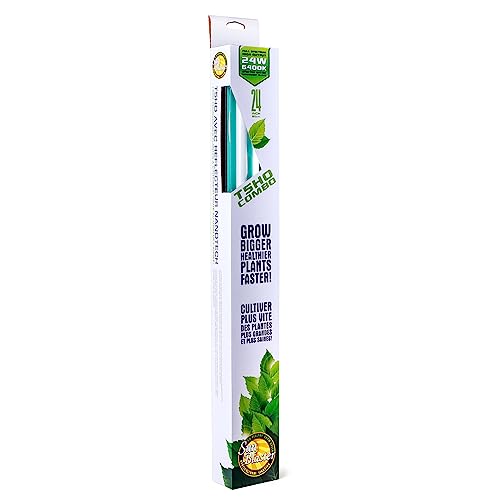Chameleons come in a variety of species as diverse as the vibrant colors they display—consequentially, there are subtle variations to each species’ ideal environmental conditions.
There’s no reason to worry if that previous statement triggered a startling revelation.
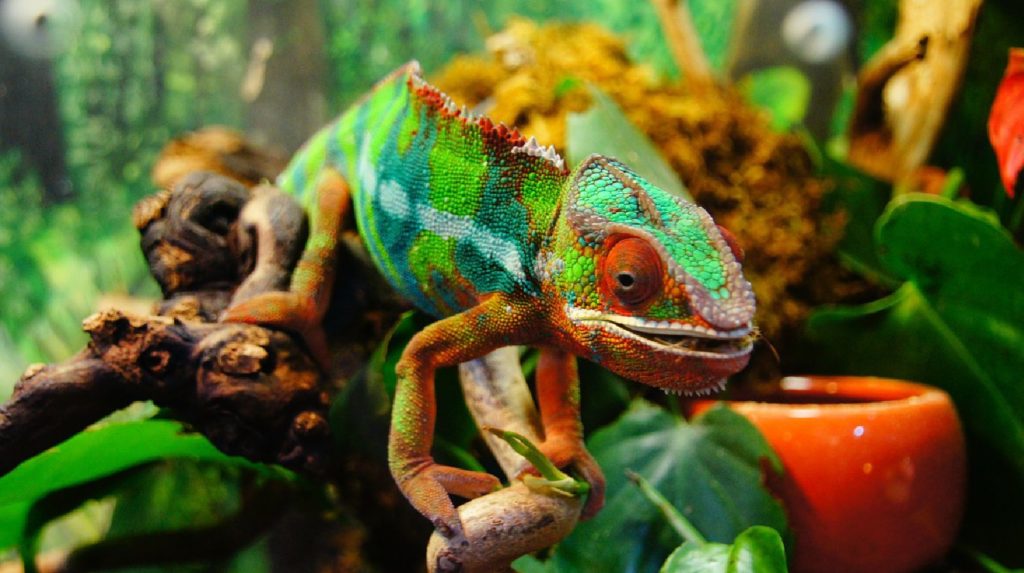
Reptile Advisor is, after all, here to advise anyone new (or relatively new) to housing a chameleon companion on the finer points of constructing a suitable habitat for their well-camouflaged friend.
We’ve constructed a short but comprehensive guide that groups chameleons into regional categories and outlined the essentials for keeping them comfortable.
Quick Navigation
Chameleon Types & Their Temperature Preferences
Here are the two main regional categories of chameleons (and a few of their specific care needs):
Madagascan Chameleons
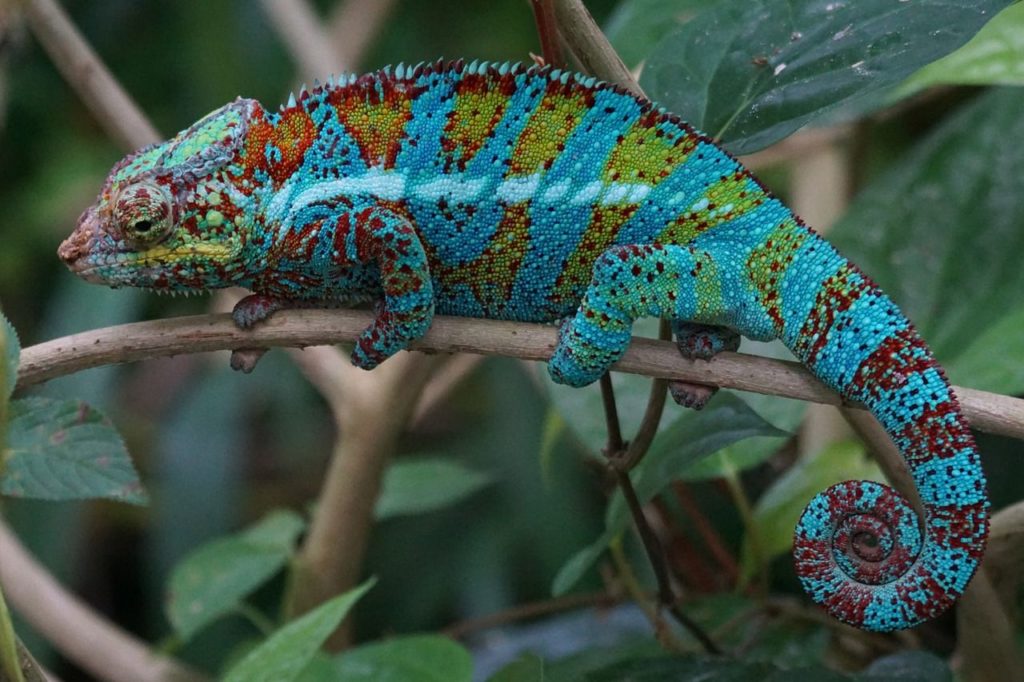
Chameleon species native to Madagascar make up a significant portion of those commonly kept as pets. Popular examples include the Carpet Chameleon, Oustalet’s Chameleon, and Panther Chameleon.
These chameleons enjoy moderate temperatures and humidity, with suitable daytime temperatures hovering at 75°F for the Carpet Chameleon and 80°F for the Oustalet’s and Panther Chameleons. Enclosure humidity should ideally never fall below 70% for all chameleons in this subset.
Temperatures in these reptiles’ natural habitats can soar well above 100°F; however, it would be ill-advised to expose your reptile to constant temperatures in this range.
The temperatures listed above are ambient daytime temperatures. Your chameleon should not be able to climb close enough to the enclosure lighting to be exposed to triple-digit heat.
African Chameleons
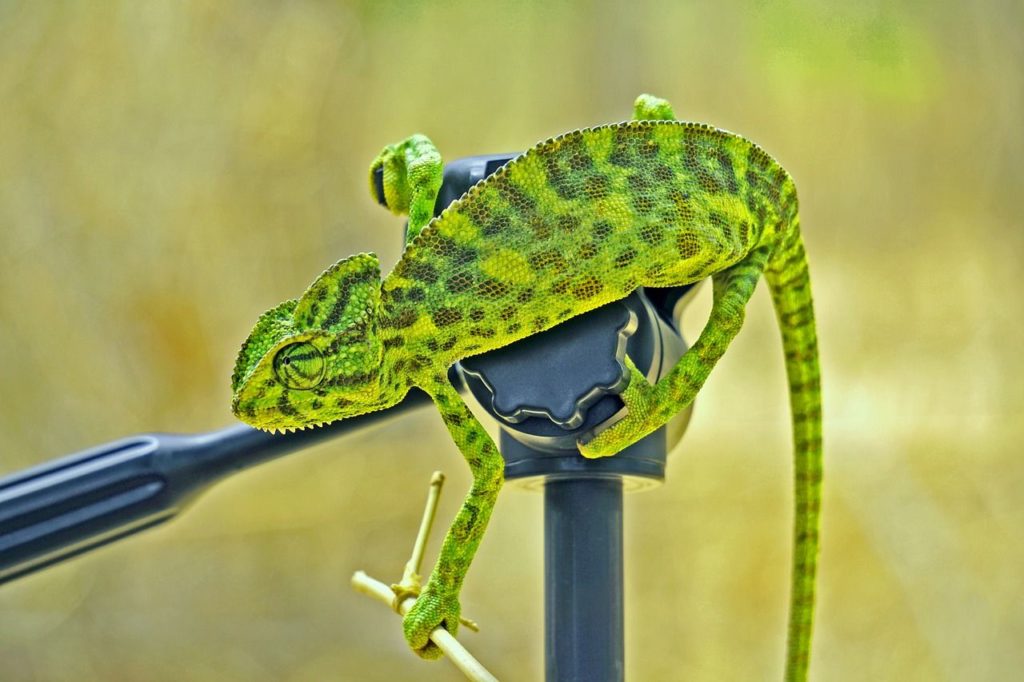
Many of the other chameleons hailed as wonderful pets are native to Africa. This subset includes the Flap-Necked Chameleon, Jackson’s Chameleon, and Meller’s Chameleon.
The Flap-Necked Chameleon prefers daytime temperatures hovering near 75°F, and the Jackson’s and Meller’s Chameleon enjoy temperatures closer to 80°F. Each chameleon thrives in slightly different humidity increments, with the Jackson’s, Meller’s, and Flap-Necked Chameleon preferring 65%, 70%, and 75% respectively.
The same rule applies here when it comes to ensuring the chameleons are not exposed to triple-digit temperatures.
For all chameleons, measure the temperatures at the highest accessible point in the enclosure to ensure they are safely below this threshold, ideally 5-10°F.
Bulb placement is perhaps the most important element of proper chameleon lighting, but you should first understand the appropriate type of lighting equipment to use.
UVB Lighting for Chameleons
Lighting any reptile enclosure involves more than picking up a lightbulb from a hardware store and calling it a day. Enclosure lighting must mimic the complete effect of the sun’s rays to effectively sustain your pet.
UVB rays are essential for sun-basking reptiles’ production of Vitamin D3. While some reptiles in this category can utilize a limited amount of Vitamin D3 contained within the food they consume, virtually all are unable to maintain sufficient levels of the vitamin without sunlight.
Vitamin D3 enables these reptiles’ absorption of calcium, and without it they can quickly develop Metabolic Bone Disease. This is effectively a leaching of calcium from bones leading to a slew of debilitating health complications. Thus, UVB lighting is an absolute must.
Choosing a UVB Light
When it comes to choosing a UVB bulb, Zoo Med’s ReptiSun 5.0 UVB tube lamp is definitely the way to go.
Important: We do not recommend using compact fluorescent UVB lamps as they can be tough on your chameleon’s eyes. Rather, we recommend using a tube lamp such as the one we linked above.
- Stronger UVB and brighter light than standard ReptiSun 5.0 lamps
- Increased UVB Output, perfect for larger reptile habitats
- Helps prevent or reverse metabolic bone disease commonly seen in captive reptiles
It is also important to remember that there is an upper limit to UVB’s beneficial effect (which is why we go with the 5.0 istead of their 10.0 version. I’m sure many of you can relate to the not-so-wonderful experience of being overexposed to sunlight.
Leading herpetoculturist (reptile/amphibian scientist) Dr. Gary Ferguson recommends 5-15uW (microwatts) per cm2 of UVB lighting for your enclosure. A microwatt is equivalent to 10-6 watts: misinterpreting these measurements could have a devastating effect on your chameleon’s health.
Bulbs with excessively-high uW UVB output are sometimes paraded by manufacturers and retailers alike as a marketing ploy to sell more units, pushing these products as offering “maximal efficiency” when they are nothing more than dangerous!
So, using the median value of Dr. Ferguson’s suggested UVB output range, a bulb providing 23,410 microwatts of UVB light is sufficient for a 4ft3 enclosure. Sounds like a pretty big number, right? This equates to only 0.02341 watts! The important takeaway here is more is not synonymous with better.
Reflectors
Something important to keep in mind when it comes to UVB rays is that they are unable to effectively penetrate plastic and glass.
UVB lamps placed atop any kind of mesh screen should be placed within a reflective housing to compensate for this effect. Reflectors are even recommended for lamps hanging within a terrarium.
There are numerous ways to construct a DIY reflector for your UVB bulbs. However, virtually all prefabricated UVB lamps already have their bulbs situated in a reflective housing.
- Grow light combo promotes incredible health, robust growth, and vigor of seedlings and cuttings;...
- Combo light fixture includes a 2-foot ballast and lamp while providing ideal spectrum for seed,...
- Full spectrum light offers quality grow lighting available for a wide variety of indoor home garden...
The Visible Light
We’ll keep this short and sweet as to not unnecessarily overcomplicated what is essentially a very simple idea.
Your chameleon lighting shouldn’t just feel like the sun—it needs to look like the sun (and moon) to properly simulate your reptile’s natural habitat.
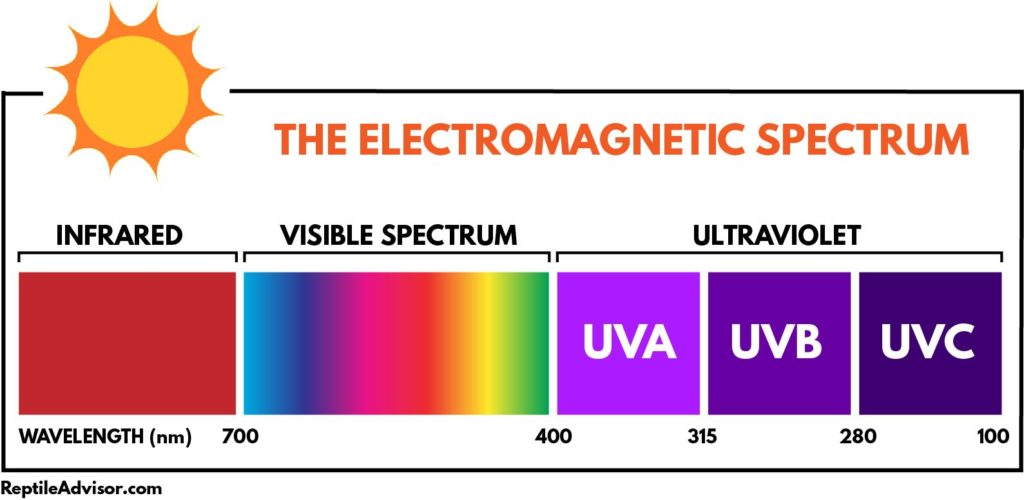
This involves three components—white light and red light (the brightness and hue of good-old-fashioned sunshine), and blue light (the soft glow of moonlight).
Accurately replicating this day and nighttime lighting will allow your chameleon to thrive in their enclosure as well as the plant life inside the terrarium.
DIY or All-In-One?
While it is perfectly common for more experienced reptile owners to construct their own chameleon lighting fixture, newer or first-time chameleon parents will find a great deal of value in pre-built lighting designed specifically to meet the specifications we’ve described.
ZooMed is a manufacturer who has been, and will continue to be, mentioned frequently within these guides. Their ReptiSun terrarium hoods are praised as near-perfect, all-in-one lighting solutions that cover the full spectrum of your chameleon’s needs. This includes a gentle blue LED array that simulates the “lunar effect” offering a complete replication of day and night cycles.
Specifically, the ReptiSun T5 HO (high output) terrarium hood is a fan favorite for regular reptile enthusiasts and long-time breeders alike. The hood includes 6500K high output, white light-producing LEDs, a red and blue LED array, and a UVB lamp.
It’s as close as you could hope to come to a plug-and-play solution. That was easy!
The Basking Lamp
A heat source, also known as a basking lamp, is necessary to help your chameleon regulate its body temperature properly.
There are numerous differing opinions on how well chameleons can self-thermoregulate in captivity, so you’re going to want an easily-adjustable heat lamp to accommodate the possibility of your chameleon basking too much or not enough.
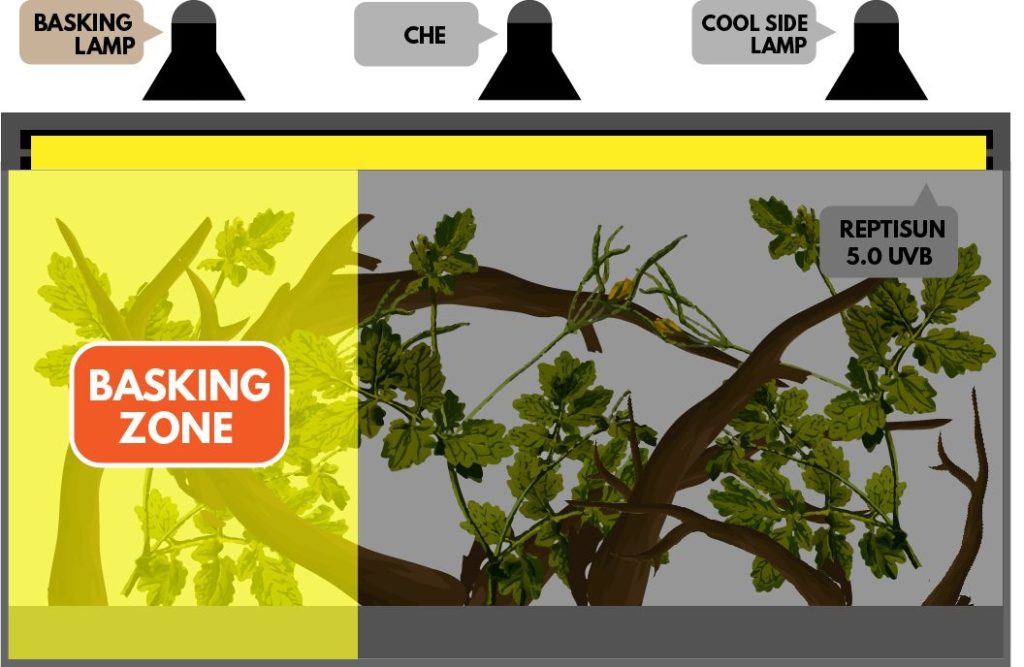
You won’t be dealing in microwatts for this component of the enclosure’s chameleon lighting but should still adhere to the philosophy of more not necessarily equating to better. Bulbs exceeding an output of 75 to 100 watts are likely to generate far more heat than your chameleon should safely be exposed to.
Now, it wouldn’t necessarily be wrong to buy a “specialized” heat lamp for your terrarium but understanding that regular light bulbs perform the same heat-producing function will likely save you a significant amount of money.
Halogen bulbs are recommended for their efficiency and affordable pricing – skip any fancy “reptile” basking bulbs.
Remember these two important things no matter what bulb you choose:
First, your heating bulb should be plugged into a dimmer switch. Once again, chameleons are not going to perfectly thermoregulate in captivity. It is common for chameleons to overexpose themselves to the basking light, sometimes completely ignoring the excess heat and refusing to move even after the temperature has become hazardous.
If you notice your chameleon displaying this behavior, keep an eye on their movement when the basking light is running and dim accordingly if they appear to be voluntarily “burning themselves to a crisp.”
Easy access to a dimmer switch will help prevent unintentional harm to your chameleon in all cases, regardless of their basking habits.
Second, all chameleon lighting (terrarium hood and heat lamp alike) should be plugged into a timer. This allows your reptile to function with a predictable day and night cycle, which can (and ideally should) be adjusted for seasonal changes.
Chameleon Lighting Placement
Your chameleon lighting should not saturate the entire terrarium in an evenly-disbursed level of heat.
The goal is to achieve a smooth gradient: your chameleons basking spot should not exceed 90 to 95°F, the highest point in the terrarium (accessible to the chameleon) should not exceed 85°F, and lower points (including shaded areas) should be kept between 70 and 75°F.
An example of a proper temperature gradient is shown here:
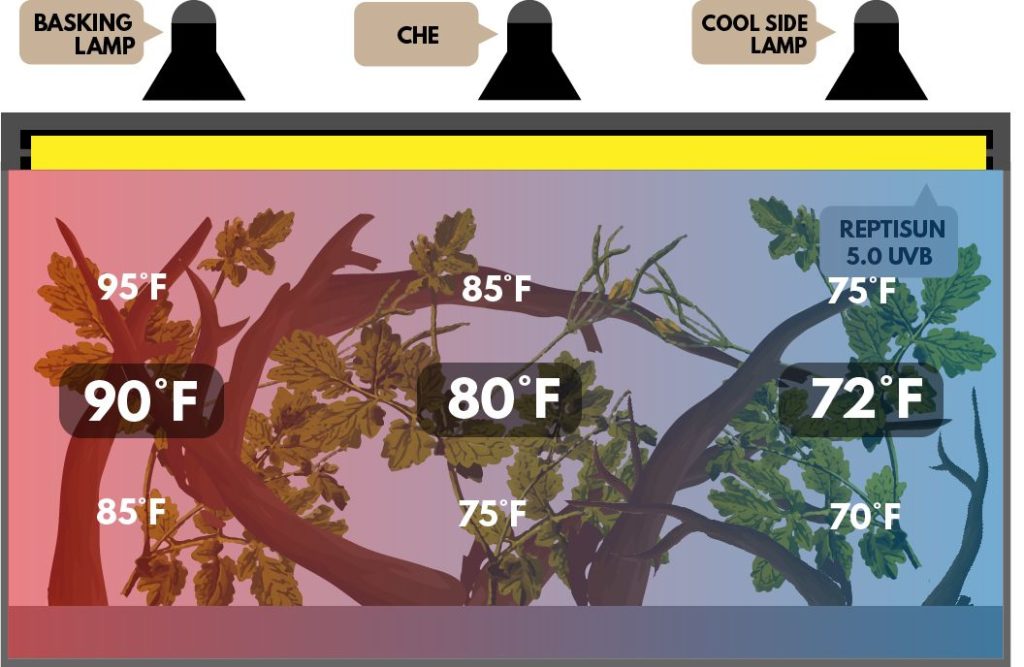
This gradient can be easily achieved by placing the primary heat source one the side of the enclosure ceiling where the hood is flush with the perimeter (i.e., opposite the side where a gap remains) and a dimmer bulb on the opposite side. For full coverage hoods, pick either side and work across.
The spot directly under your primary heat lamp (visualize a beam descending from a UFO during an alien abduction) should be your chameleon’s designated basking spot. Carefully measure temperatures around the rest of the enclosure at various vertical and horizontal differences to achieve the desired temperature thresholds.
If you’re wondering how to control the enclosure temperatures at vertical increments, this can be done by manipulating the branches of plant life in the terrarium so that separately-defined “levels” are available to the chameleon.
Once again, even under the most concentrated heat in the enclosure (the basking spot), do not expose the chameleon to temperatures above 95°F. If your pet refuses to move from their basking spot even to the point of gaping (jaw-hanging mouth breathing indicative of overheating), dim the heat lamp in increments of 2-3°F until gaping discontinues.
If you don’t have a dimmer on your light, you can also adjust the hight to of light to product the same effect. The higher you place the light, the cooler the enclosure will become.
The Zoo Med Lamp Stand is a great option if you’re looking to take this route.
Nighttime Heating
The necessity of nighttime heating for your chameleon’s enclosure is completely dependent upon the nighttime temperature of your home and the season you’re experiencing.
Spring, summer, and fall nighttime temperatures should stay at or slightly above the 70°F temperature already achieved in the enclosure’s cool spots.
Winter nighttime temperatures can acceptably reach ~5°F cooler. No matter the season, if temperatures are below these recommended minimums, a nighttime heating solution should be added to your chameleon lighting setup.
However, the heat source should not produce any light. The beneficial purpose of regulating the enclosure’s nighttime temperature is entirely defeated if the chameleon’s sleep cycle is disturbed.
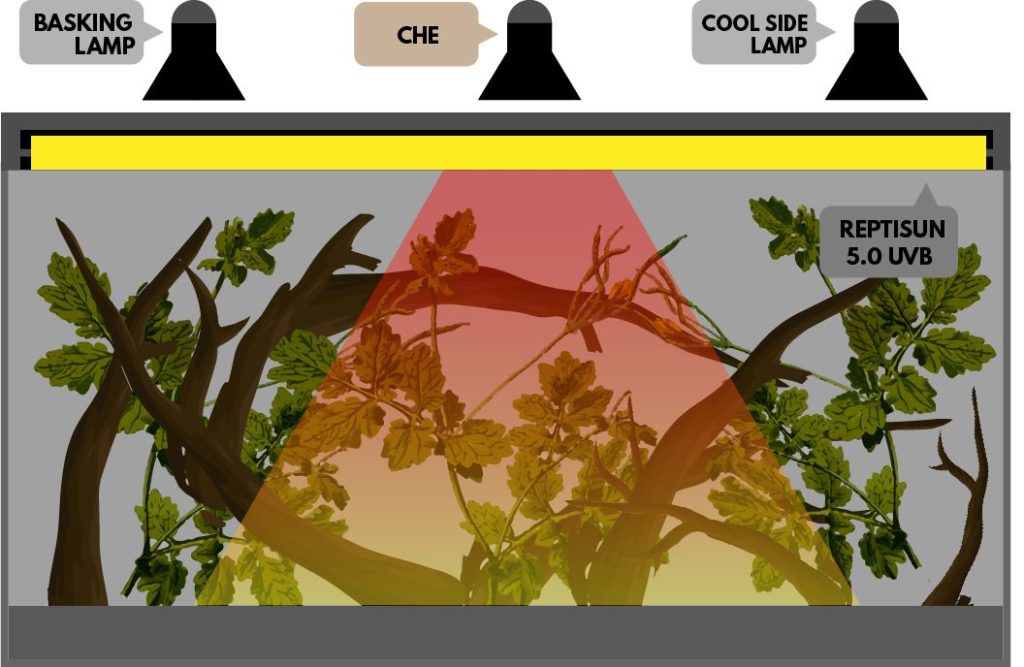
Ceramic heat emitters (CHE) are the choice tool for achieving the ideal temperature during your chameleon’s sleepy time. These lamps produce heat using infrared bulbs, warming the enclosure without the intrusion of visible light.
The CHE should be place on the top-middle of the enclosure, allowing for an evenly-distributed warmth throughout the terrarium. We recommend the Fluker’s Ceramic Heat Emitter.
What Else Is There?
Here are a few other things you should keep in mind when putting together a chameleon lighting setup:
Try different bulb placements
Chameleons, like humans, are unique in their personalities. No two creatures are the same despite their basic survival needs being virtually identical.
This is crucial to remember when arranging your chameleon lighting. The process will inevitably involve trial and error: begin by constructing a generic setup that covers all the essentials and then observe your pet’s behavior.
Their favorite basking spot could be quite far away from the one you intended, in contrast to the scenario described earlier. You may want to have extra heating bulbs arranged across the enclosure: this is not to say they should all be running at maximum brightness, and naturally the addition of extra bulbs should offset the brightness of the others you’ve included.
While extra bulbs add extra cost, it will save you some frustration compared to manually rearranging the chameleon lighting arrangement as you grow to understand the habits of your pet. Once their routine is firmly established, you can remove and store any unneeded bulbs.
Plant life is very important
Another potentially useful bit of foresight is to add slightly more plant life than the standard 50/50 ratio. This doesn’t mean you should give your chameleon access to dangerous hotspots but rather provide them more options within the different gradient levels throughout the terrarium.
Observe your chameleon and develop an understanding of their favorite hangouts. Prune branches that are ignored by your pet until that golden ratio of plant life to open space is achieved.
These are opinion-based suggestions and by no means necessary when designing your chameleon lighting setup. However, providing your pet with choices is important regardless of whether you decide to follow this top-down approach.
No setup is absolutely perfect
Reptiles, amphibians, fish, birds, mammals, unicorns—none of these animals have been introduced to an inherently ideal situation by being removed from their natural habitat. They can certainly be provided wonderful lives in captivity, but it is up do you to do so. The health and happiness of this creature is entirely dependent upon you: proceed thoughtfully.
Quick Guide to Chameleon Lighting
Here are some of the most important points to remember from this article:
- Temperature benchmarks used for chameleon enclosures are ambient daytime temperatures. Just because chameleons are naturally exposed to temperatures above 100°F does not mean that replicating this with your chameleon lighting is good for their health (it is not).
- Failing to add a source of UVB rays to your chameleon lighting is a recipe for a very sick chameleon. These reptiles need UVB rays to maintain a healthy level of nutritional absorption and bone composition. Reflective housing is often necessary for UVB bulbs. Fortunately, preconstructed terrarium hoods like ZooMed’s T5 HO take the guesswork out of this crucial step.
- A little goes a long way with UVB rays. Overdoing the amount of UVB rays flooding into the enclosure could have severely adverse effects on your chameleon’s health.
- Chameleon lighting should replicate not only the temperatures they’re naturally exposed to but the day and nighttime lighting color spectrum as well. Once again, preconstructed terrarium hoods will remove virtually all guesswork.
- Temperatures within a chameleon enclosure should exist in gradients. Your pet needs to be able to move away from their more intensely-heated basking spot into cooler and sometimes shaded areas. One of the purposes of the plant life in your terrarium is to facilitate this temperature gradient.
- Chameleons living in a terrarium are unlikely to perfectly replicate thermoregulation with the same efficiency they do in their natural habitats. You must carefully observe your pet’s behavior and adjust their heat exposure according to the extent they are over or underexposing themselves.
- While preconstructed terrarium hoods are highly recommended, bulbs intended to serve as heat sources can simply be purchased from a hardware store. Specialized heat lamps exist of course, but their function is no different and fails to justify the added cost.
- Dimming switches and lighting timers are necessary. These enable the full control over the chameleon lighting environment that you must have to ensure the optimal living conditions for your pet. They are inexpensive, and it is inexcusable to ignore their addition to the enclosure.
- Nighttime heating is not inherently necessary for your terrarium unless your home’s nighttime temperature falls below the minimum seasonal threshold for your chameleon. If a heat source must be introduced, include a ceramic heat emitter (CHE) in your enclosure. They emit infrared light and will not disturb the sleep cycle of your chameleon.
- Ensure that your chameleon has options when it comes to perches distributed throughout the heating gradient within their enclosure.
Another bit of advice I’d like to add is to avoid purchasing used equipment when constructing your chameleon lighting.
Saving a few dollars might seem enticing, but the potentially compromised functionality of the equipment is hardly ever worth pocketing those savings. Besides, virtually all the lighting options you’ll uncover are quite affordable.
Best of luck with your reptile parenting journey, and thanks so much for stopping by!
Last update on 2025-07-16 / Affiliate links / Images from Amazon Product Advertising API

